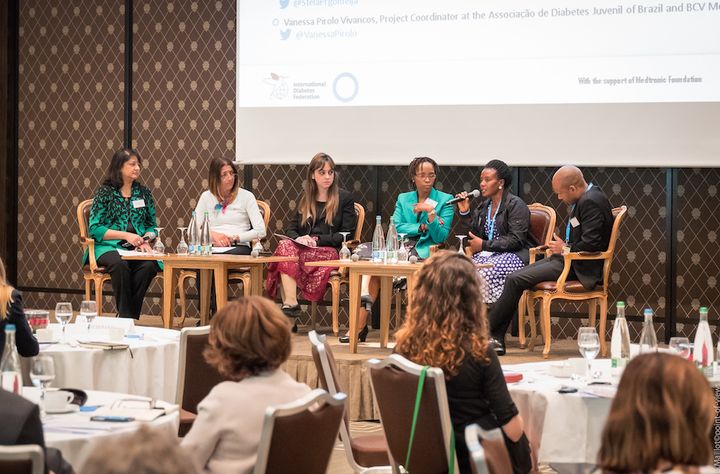
Introduced by IDF Acting President Professor Nam Cho
Two weeks ago at the 70th World Health Assembly in Geneva, the International Diabetes Federation (IDF) said we are not merely in the business of counting people with diabetes - but making people with diabetes count. I had the privilege to introduce to a full ballroom IDF’s new patient leadership group, the Blue Circle Voices (BCV).
The Blue Circle Voices, of which I am a member, are 103 diabetes advocates and their loved ones and caregivers living in forty three IDF member countries. We are IDF’s advocates and activists on the ground reporting on diabetes issues in our countries - access to care, awareness and education, diabetes prevention, promotion of healthy lifestyle, government policies and discrimination.
It’s been shown that increased patient engagement improves diabetes care for people with diabetes living everywhere. Yet IDF amplifying the “voice of the patient” is like salmon swimming upstream. Although people with chronic illnesses are the key stakeholder in their health, they are almost invisible among those crafting and dispensing our care - health professionals, pharmaceutical companies, device companies, insurance companies, Medicare, public health officials, corporations and government. Where is the person living with illness?
Eighteen months ago at IDF’s last World Congress in Vancouver, people with diabetes were well represented chairing sessions, presenting and participating on speaker panels. My husband and I both noted how integrated people with diabetes were at the conference - the only global, and largest, attended diabetes conference in the world. This is hardly the case at the majority of diabetes conferences.
Our event at WHO, “Access to Diabetes Medicines and Care in Underserved Populations: Patient, Health Worker, Government and Multilaterial Perspectives on Policy,” organized in collaboration with Medtronic Foundation, opened with an introduction from Professor Nam Cho, IDF’s President Elect, followed by Dr. Etienne Krug sharing WHO’s targets and vision. It closed with a fifty minute speakers panel consisting of a nurse, community health worker, diabetes activist and two BCV members sharing their countries’ challenges and successes.

Speaker panel: left to right, Moderator Paurvi Bhatt, Sr. Dir Global Health Medtronic Foundation; Stela Prgomelja, VP Serbian Diabetes Association, BCV; Vanessa Pirolo, Association of Juvenile Diabetes, Brazil, BCV; Kwanele Asante-Shongwe, Bakken Honoree, SA; Samalie Kitooleko, Nurse Uganda; Dr. Sanele Madela, CHW, SA
In addition to introducing the Blue Circle Voices initiative, I was also asked to share the state of healthcare in my country, America. You may not think America would be included under the session’s banner. You would be wrong.
Traveling across the U.S. for the past ten years as a peer-mentor I have met thousands of people with diabetes. Those on Medicare often complained of not being provided enough test strips to keep their blood sugar well managed. Medicare members get no coverage for insulin pens, used overwhelmingly in Europe. Insulin pens make dosing, particularly for older people and people with type 2 diabetes, easier, more convenient and less stigmatizing.
Only a few months ago, after a long battle with diabetes organizations and patients, Medicare gave conditional approval for life-saving CGMs (continuous glucose monitors) in spite of the fact that the most vulnerable population to hypoglycemia are people with type 1 diabetes over the age of 60.
While we are more fortunate than many countries - I have seen firsthand corruption in India that stole a young woman’s use of her hands, been told that in Japan diabetes means “disturbed lifestyle” and heard stories of transporting insulin to third world countries only to have it sit and spoil because there are no trucks to get it to rural villagers - America’s healthcare is currently in disarray.
People with pre-existing conditions like diabetes may, when we emerge from this typhoon, find they can no longer get health insurance. Or can no longer afford it. We are hearing drumbeats already that health insurance premiums will increase significantly to make up for tax breaks the government may withhold from insurers.
In healthcare today it is sadly noteworthy that organizations like the IDF and the World Health Organization recognize the patient as a bonafide stakeholder in their care, not just the object of health policies. It is to be commended when we get much deserved seats at policy-making sessions or are included in any way as contributors.
I certainly hope one day this will just be everyday business. I know many of us living with diabetes have the capacity, desire and are ready change agents to improve the lives of people living with diabetes. Currently we need more organizations to believe it too.
For now, I am grateful to be in a position to bring the patient voice forward. I close with three videos, two from fellow BCV members that were shown in Geneva. Here are three Blue Circle Voices sharing the experience of diabetes discrimination, shining a spotlight in the darkness as only those living with diabetes can do.